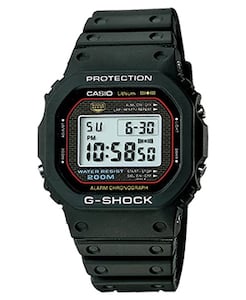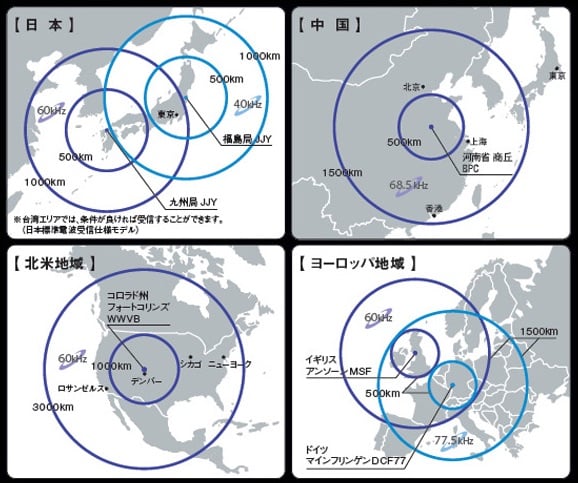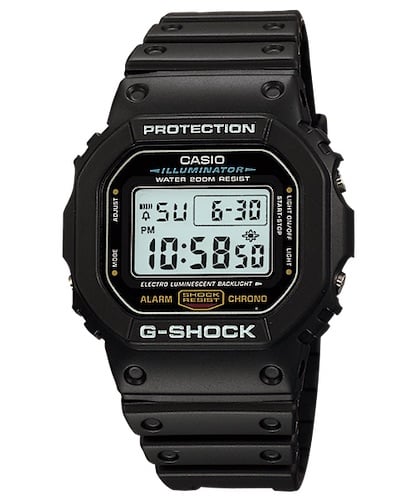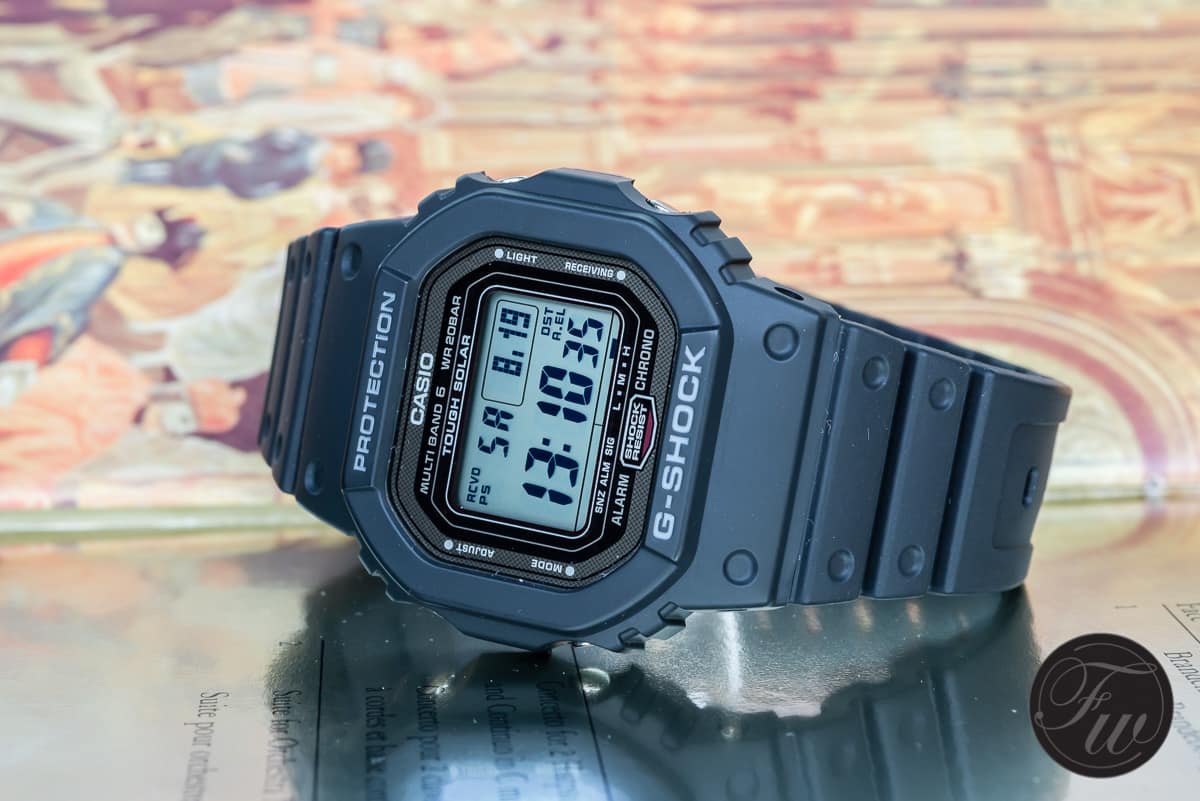You Asked Us: G-Shock Square Which One To Choose?
Many of you will know that we, the authors at Fratello, are privately active on several social media channels. For instance, we love to take part in discussions and share our suspected knowledge in Facebook groups. Besides our effusive interest in horology in general, we have our personal specific fields of interest. And so it comes that you’ll often find us dwelling at specialized groups which reflect our personal preference or specialism.
It will be no surprise that you’ll find me in Facebook groups like ‘Omega Mania’ and ‘#speedytuesday’. However, there’s another, probably lesser known, field I’m interested in. And that is Casio G-Shock Squares. In this weeks You Asked Us instalment I’ll publish a question which was posted in the ‘G-Shock Square’ Facebook group and which got many reactions.
Which G-Shock Square Should I Buy, G-5600E-1 or GW-M5610-1?
In fact, the exact question from Anton was the following:
Hi squares,
I’m going to buy a G-Shock this week and can’t make up my mind which one I should go for. Looking for any help/tips on the matter. Should I go for G5600E-1 or GWM5610-1?
A, for me a quite understandable question, although for most of you all black cased G-Shock Squares might look the same. As often with watches, it’s all in the details.
A historic little red line
The little red line around the dial of the GW-M5610-1 will be a detail probably noticed first. In combination with some other printing in the dial, that’s the most remarkable visual difference between these two watches. And immediately it’s an interesting one as well. As probably known, the origin of the Casio G-Shock dates back 36 years. Designed and developed by Kikuo Ibe, Casio in 1983 introduced the first watch according to their Tripple-10 concept. Waterproof to 10 bar, drop-proof to 10 meters and 10 years battery life. The Casio G-Shock DW-5000C was born. Mind you, 1983 was the year the first mobile phone was introduced as well, and meanwhile, Casio sold over 100.000.000 G-Shocks worldwide.
The 1983 G-Shock DW-5000C, as shown here above, had that remarkable red line around its dial as well. If one’s looking for an optically most original modern offspring from the first Square G-Shock, I can imagine the GW-M5610-1 comes to mind. Personally, I could do very well without the red line though. The more details attracting attention, the sooner I tend to get bored with it.
Functionality
In terms of functions, both watches are very equal. Except indicating the time (in 12 or 24-hour format) and date, both sport a 1/100s chronograph, a countdown timer, 5 daily alarms, and the possibility to show the time in 48 different cities plus UTC. Both, the G-5600-E and GW-M5610-1, have a full automatic backlight function. The backlight comes on with the turn of your wrist towards your face. This function is automatically activated under dim light or dark conditions and deactivates when the surrounding light is sufficient.

Showing the significance of Casio’s G-Shock watches. Astronaut Thomas Reiter using his (non-Square by the way) G-Shock in the ISS Spacestation during mission SSI-014 in December 2006.
Technical differences
Tough Solar
A quick dive into the specifications, or even a quick look at the dials of the aforementioned two models, learn that both watches sport solar power supply. Or as G-Shock indicates it, Tough Solar. A very useful feature, in my opinion, I love when I don’t have to think about changing batteries. Prevents a lot of hassle and additional costs too. G-Shock’s Tough Solar charging system converts not only sunlight but also light from fluorescent lamps and other sources into power.
Multi-Band 6
The G-5600-E does not only lack the red line in the dial, but it also lacks the ability of automatic time adjustment. With the GW-M5610-1 this is achieved by a feature Casio names Multi-Band 6. Multi-Band 6 is a radio signal based time adjustment system. Whether in Europe, North America, Japan, or in the outer reaches of Canada, Central America, and China, once the watch has been set to the local time, it’s able to receive a relevant signal and shows the correct time wherever you are. In many countries, it also sets itself automatically to summer and winter time.
Again, in my opinion, a very useful feature. Most non-radio-adjusted G-Shock’s tend to run quite a few seconds off every month, which makes it that you need to adjust the time manually. Always a challenge to see if you could remember how that was exactly done. But, and I mentioned that already, the radio signal isn’t available everywhere on earth. So if you reside in Central-Asia, Australia, Soth-America, the best part of Russia, or for instance the Northern part of Scandinavia, this feature would not be decisive for you.
A preliminary choice
From Anton’s Facebook profile I learned that he lives in Keflavik, Iceland. Iceland, unfortunately, is just outside the reach of the 60 KHz Anthorn radio-signal in North-West England which serves the Multi-Band 6 system in that area. And thus the GW-M5610-1’s radio signal based time adjustment system is of little use to Anton.
Remains the rather personal question if one likes the more present red line on the dial of the GW-M5610-1 or the modest white line on the G-5600-E. Something I can’t decide for Anton, and it would be a close call for me personally as well. Because of the availability of a Multi-Band 6 usable signal in my part of the world, I might have overcome my slight preference for the more modest white line and would choose the technically more advanced GW-M5610-1. To be totally honest here, I added both models to my collection, just to be sure.
Prices, prices…
There might be another reason why one would choose one over the other, and that’s the price. The G-5600-E can easily be found for around $ 85.= while the GW-M5610-1 will set you back at least $ 100.=. For a $ 15.= difference, I can hardly imagine that this would be a deal breaker if one should really fancy one model above the other.
Lower
And in the case that price does matter, I would like to propose another possibility. As one of the basic G-Shock Squares, there’s the DW-5600E-1 as well. Visually quite equal to the G-5600-E (white line on the dial), however, lacking the Tough Solar power functionality. This means one has to change batteries, but that’s only after 10 years of operating which very well might not scare you off. The lower price comes at other costs as well though. The DW-5600E-1 does not have the 48 cities world time functionality. It has only one multifunction alarm, and the calendar only runs to the year 2039 instead of 2099. And there’s no automatic backlight function either. However, it can be yours for $ 45.=.
Higher
And then, of course, there’s always a higher price. During the years, without scrutinizing the toughness nor Tripple-10 concept, Casio changed the construction of their G-Shocks substantially. While in 1983 the DW-5000C had a solid stainless steel inner case, current regular G-Shock inner casings are made of plastic. This being the case with the G-5600-E and GW-M5610-1 of this article as well. Probably nothing wrong with that, and it certainly made them lighter in weight and cheaper to produce.
Whether or not a G-Shock has a plastic case construction can be easily told by the form and structure of the case back. If the case back is made of a stamped metal plate and fixed by four little Phillips screws, the inner-casing will be plastic. If on the other hand the case back is round and screwed into the casing by itself, the watch has a stainless steel inner casing.
Casio still produces G-Shocks with a solid stainless steel inner casings. Often in special or limited commemorative models, however, in a regular collection model as well. The GW-5000-1. To me, this is the ultimate currently available G-Shock. Construction-wise loyal to the original G-Shock from 1983, and technically foreseen with all bells and whistles like Tough Solar and Multi-Band 6. I love the more substantial feeling of this solid stainless steel inner casing model, as well, its rubber strap seems of a higher quality and it wears more comfortable than others. And as a cherry on my cake, the GW-5000-1 doesn’t have a red line on its dial 😉 My advice to Anton would be to save up a little extra and go for the GW-5000-1.
While most G-Shocks with plastic inner casings are produced in Thailand or China, stainless steel inner casing models are produced in Japan. Except for the more costly construction of these watches, this might be part of the reason for the GW-5000-1’s almost $ 300.= price-tag.
More information on Casio G-Shock can be found at g-shock.com








